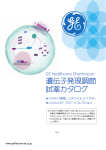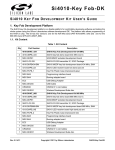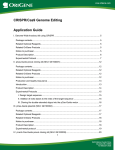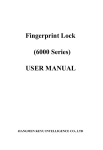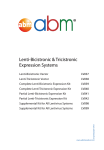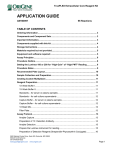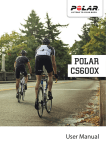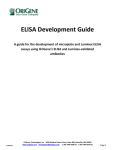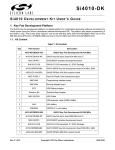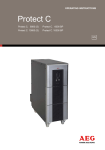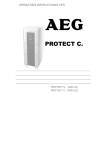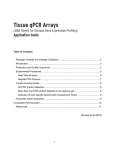Download TrueORFs - OriGene
Transcript
TM TrueORF cDNA Clones and PrecisionShuttle Vector System TM Application Guide Table of Contents Package Contents and Related Products .............................3 Related Optional Reagents ...................................................3 Related OriGene Products ................................................3 Notice to purchaser ...............................................................4 The same ORF is offered in 4 different expression vectors ..4 Non Lenti-based Vectors (Figure 1): .................................4 Lenti Vectors (Figure 2): ....................................................4 Experimental protocols .......................................................11 Detect protein over-expression using anti-DDK antibody 11 Primer Design and PCR Amplification of ORF ................11 Cloning of ORF into the Entry Vector ..............................13 Transfer of ORF from TrueORF Entry Vector to destination vectors ................................................................................15 Subcloning with OriGene’s RapidShuttling Kit: ................15 Subcloning without OriGene’s RapidShuttling Kit: ...........15 Protocol for Transient Transfection .....................................17 Protocol for Stable Transfection .........................................18 1 Lenti-based protocols: .....................................................19 Troubleshooting ..................................................................20 Frequently Asked Questions ...............................................21 Revision 10.14 -2- Package Contents and Related Products The following components are included: One (1) vial containing the cDNA clone as 10 ug lyophilized plasmid DNA*. Forward (VP1.5) and reverse (XL39) sequencing primers for non Lentibased vectors or Forward (VP2.0) and reverse (LR50) sequencing primers for all Lenti vectors; dried onto the bottom of screw cap tubes. Certificate of Analysis Application Guide * OriGene plasmids are purified using ion-exchange columns for high-yield, low endotoxin preparations (PowerPrep® HP Midiprep Kit www.origene.com/other/Plasmid_Purification.) The cDNA clone is shipped at room temperature, but should be kept at -20C for long-term storage. If properly stored, clones are guaranteed to be stable for 12 months. Related Optional Reagents Restriction enzymes and buffers Sgf I/ASIS I from Fermentas Mlu I from Fermentas or New England Biolabs Nuclease free water T4 DNA ligase and buffer Competent E. coli cells LB agar plates with kanamycin, 25 g/ml (Entry vector) LB agar plates with ampicillin, 100 g/ml (Destination vectors, non-Lenti) LB agar plates with chloramphenicol, 34 g/ml (Destination vectors, Lenti-based) LB broth (10 g/L Tryptone, 5 g/L Yeast Extract, 10 g/L NaCl. Adjust pH to 7.0 with 1 N NaOH) DNA purification reagents Anti-FLAG Antibody – 4C5-AntiDDK (OriGene TA50011) Related OriGene Products TrueClone™ FL cDNA clones CRISPR RNAi products TM VERIFY Tagged Antigens Validated Antibodies Purified Proteins Transfection Reagents 4C5-Anti-DDK Antibody 2H8-Anti-tGFP Antibody http://www.origene.com/cdna http://www.origene.com/CRISPR-CAS9/ http://www.origene.com/RNAi/ http://www.origene.com/lysate/ http://www.origene.com/antibody http://www.origene.com/protein http://www.origene.com/cdna/transfection.mspx http://www.origene.com/antibody/4C5-AntiDDK http://www.origene.com/antibody/2H8-AntitGFP -3- Notice to purchaser This product is for research use only. Use in and/or for diagnostics and therapeutics is strictly prohibited. By opening and using the product, the purchaser agrees to the following: The plasmids may not be distributed, resold, modified for resale or used to manufacture commercial products without prior written approval from OriGene Technologies, Inc. If you do not agree to the above conditions, please return the UNOPENED product to OriGene Technologies, Inc. within ten (10) days of receipt for a full refund. The same ORF is offered in 4 different expression vectors Non Lenti-based Vectors (Figure 1): pCMV6-Entry: In this vector, a TrueORF sequence is fused with a MYC/DDK tag at its carboxy terminus. The antibiotic selection marker for E. coli is kanamycin (25ug/ml), and neomycin (G418) for mammalian cells. Unlike an entry clone in other shuttling systems, OriGene’s entry vector is a functional mammalian expression vector. The small dual tags facilitate the detection and purification of the ORF product with anti-Myc or anti-DDK antibod. pCMV6-AC-GFP: In this vector, a TrueORF is fused with turboGFP at its carboxy terminus. The antibiotic selection marker for E. coli is ampicillin (25ug/ml), and neomycin (G418) for mammalian cells. The green fluorescence tag allows one to monitor the ORF product in live mammalian cells. Lenti Vectors (Figure 2): pLenti-C-MYC/DDK: In this vector, a TrueORF is fused with Myc andDDK tags at its carboxy terminus. The antibiotic selection marker for E. coli is Chloramphenicol. The lenti-based vector allows the TrueORF insert to be packaged into pseudoviral particles and to be introduced into some difficult-totransfect cells through infection. The small dual tags facilitate the detection and purification of the ORF product with anti-Myc or anti-DDK antibody. pLenti-C-mGFP: In this vector, a TrueORF is fused with a monomeric GFP at its carboxy terminus. The antibiotic selection marker for E. coli is chloramphenicol. The green fluorescence tag allows one to monitor the ORF product in live mammalian cells. The monomeric GFP tag can avoid a potential mistranslocation of a target caused by dimeric form of GFP such as tGFP. Note: For LentiORF clones, due to the long-terminal repeats in the vector, to make more plasmid DNA, recombination deficient E. Coli competent cells are recommended, such as Stbl3 from ThermoFisher. In addition to the commonly used vectors listed above, OriGene provides over 90 PrecisionShuttle vectors for a variety of utilities, different epitope tags or -4- fluorescent protein tags, different mammalian selection markers or expression systems. Two new AAV2 expression vector are just launched for transducing difficult-to-transfect cells. A TrueORF insert can be shuttled easily among all PrecisionShuttle vectors with a pair of restriction enzymes and the tags will be in frame with the gene if the same pair of enzymes are used. For detailed vector information (sequence, map, tag location, and cloning sites) go to http://www.origene.com/cdna/trueorf/destinationvector.aspx Figure 1. The Vector Maps of pCMV6-Entry and pCMV6-AC-GFP. Multiple cloning site of the PrecisionShuttle pCMV6-Entry Vector Multiple cloning site in the PrecisionShuttle pCMV6-AC-GFP Vector -5- Figure 2. Lenti Viral Vectors Multiple cloning site of pLenti-C-Myc-DDK Vector Multiple cloning site of pLenti-C-mGFP Vector -6- The PrecisionShuttle Vector System The TrueORF vector system is designed to express the ORF of a gene with one or more epitope tags or with a fluorescent marker. There are more than seventy destination vectors in the PrecisionShuttle vector system. These vectors are either N-terminally tagged (pCMV6-AN) or C-terminally tagged (pCMV6-AC). Available tags include Myc, DDK, His, HA, and tGFP and many others (http://www.origene.com/cdna/trueorf/destinationvector.aspx). One untagged PrecisionShuttle vector is also available to express the untagged protein in mammalian cells, or using an in vitro protein expression system. Due to the requirement for the Mlu I restriction site, the untagged vector does still append two amino acids (TR) to the C-terminus of the encoded protein. Figure 3. Potential applications of the PrecisionShuttle system for protein analysis. The TrueORF cDNA clones in the pCMV6-Entry vector and other N- or C-tagged-vectors can be directly used in your experiments. TM All of the plasmids in the PrecisionShuttle vector system are designed for high-level target gene expression in mammalian cells or in vitro translation in a cell-free system. The plasmids contain the promoter and enhancers of the human cytomegalovirus (CMV) immediate-early gene to drive mammalian gene expression, and the T7 promoter for in vitro transcription/translation. A Kozak consensus sequence is included in the plasmid to enhance mammalian expression. The PrecisionShuttle vector system employs a basic “cut and ligate” molecular cloning method (Figure 4). It is faster, cheaper, more reliable and flexible than a recombination strategy, and no intellectual license is required for either academic or commercial users. The transfer of the ORF from the Entry clone to any destination vector is a rapid process. Digestion, ligation and transformation take as little as 3 hrs (Figure 4) since the Entry vector and destination vectors use different antibiotic selection markers. Unlike recombination-based systems in which the Entry clone is only a preliminary product, OriGene’s Entry Vector contains C-terminal Myc and DDK tags, and can be used directly for many applications including 1) tagged protein expression (C-terminal Myc/DDK in -7- mammalian cells and 2) tagged protein expression in a cell-free system using the T7 promoter. Figure 4. Schematic of the PrecisionShuttle subcloning procedure. The Entry and destination vectors are digested with Sgf I and Mlu I or other specified enzymes. After a ligation reaction, the resulting clones are grown on ampicillincontaining plates to select for successful subcloning of the ORF into the destination vector. Two rare-cutting restriction enzymes are utilized in transferring an ORF between vectors. Most subcloning from the Entry to a destination vector involves Sgf I/Asis I (present in 0.37% of human ORF) and Mlu I (4%). In the very unusual case when Sgf I and Mlu I sites are inside the ORFs, the TrueORF vector MCS provides other rare restriction sites, such as Asc I, Rsr II, and Not I so that any ORF can be shuttled from the Entry vector to a destination vector by using some combination of these five rare restriction enzymes. Unlike site-specific recombination vector systems, the TrueORF Clone System does not append multiple amino acids to the amino or carboxy terminus of the protein of interest. The subcloning strategy maintains insert orientation and reading frame, -8- eliminating the need to resequence the insert after each transfer. Because the Entry and destination vectors have different antibiotic resistance genes, selection after subcloning is a very simple process. Therefore, the shuttling process can be readily adapted to a 384-well format. With the availability of over 32,000 unique full-length human cDNA clones and mouse and rat clones, OriGene is in an enviable position to develop and support such high throughput applications. While the PrecisionShuttle vector system can be used for any cDNA, we have developed this system to take advantage of the largest collection of full-length cDNA clones available at OriGene. Every cDNA clone is offered in the Entry vector as a TrueORF clone, and the customer can easily transfer this ORF into any destination vector. A special effort has been made during the synthesis of these TrueORF clones to minimize the generation of mutations. Using a large quantity of high-quality cDNA template, a minimum of PCR cycles and a polymerase with the highest fidelity (one mutation in 40,000,000 bp), the number of PCR mutations is very limited. No mutations were identified during the initial cloning of over 200 ORF cDNAs (ranging from 500-6000bp) into the Entry vector after full-length sequencing of each of these clones. The MCS of the PrecisionShuttle vectors was engineered to be compatible with most other commercially available vector systems including Gateway vectors (Invitrogen), PET vectors (Novagen) and Flexi vectors (Promega). In this sense, the TrueORF vector system is truly universal. The PrecisionShuttle Entry and destination vectors contain the neomycin phosphotransferase gene under the SV40 promoter. Expression of the neomycin phosphotransferase gene in mammalian cells allows stable cell selection with a neomycin analog such as G418. Destination vectors with alternative selection markers (e.g. puromycin, blasticidin, hygromycin, etc.), are also available. A complete and up to date listing of these vectors can be found on our website at http://www.origene.com/cdna/trueorf/destinationvector.aspx . The development of the PrecisionShuttle vector system has gone through a rigorous quality control (QC) process. Both the Entry vector and the destination vectors have been validated for transient and stable mammalian cell transfections using a tGFP marker (data not shown). The expression of Nterminal and C-terminal fusion tags has been validated by Western blot analysis (shown in Figure 5). -9- Figure 5. Western blot analysis of proteins expressed from N-terminally and Cterminally tagged PrecisionShuttle vectors. Each lane of the blot contains the whole cell lysate from an overexpression experiment using a PrecisionShuttle vector. BLK represents human B lymphoid tyrosine kinase (NM_001715); BTK represents human Bruton agammaglobulinemia tyrosine kinase (NM_000061). These two cDNAs were cloned into the destination vectors identified at the top of the blot. GFP represents one empty destination vector, pCMV6-AC-GFP, used for cloning C-terminal GFP fusion proteins. Specific antibodies against BLK and BTK detected the same size proteins as antibodies against the N-terminal and C-terminal tags. - 10 - Experimental protocols Detect protein over-expression using anti-DDK antibody The protein expression level can be detected using anti-DDK antibody (OriGene product number TA50011, 4C5-Anti-DDK monoclonal antibody) with Western blotting method. This antibody is shown to be 5-10 times more sensitive than Sigma’s M2 anti-FLAG antibody. Therefore, it is important to use TA50011 mAb when accessing protein over-expression using OriGene’s TrueORF clones. When OriGene’s 4C5-Anti-DDK monoclonal antibody is used, the suggested starting dilutions are 1:2000 for Western blot, 1:200 for immunoprecipitation and immunostaining, and 1:1000 for immunofluorescence. Primer Design and PCR Amplification of ORF The open reading frame (ORF) of the clone must be PCR amplified in order to append cloning sites to the 5’ and 3’ ends of the sequence. Add the target sequences of the selected restriction enzymes to the forward and reverse PCR primers; examples are shown below. Forward primer with Sgf I 5’ GAGGCGATCGCCNNNNNNNNNNNNNNNNNNNNNNN 3’ Ns represent the sequence of the ORF beginning with the start codon, ATG. It is important to add the additional “C” base after the Sgf I site to maintain appropriate reading frames with N-terminal tags in some destination vectors. Reverse primer with Mlu I 5’ GCGACGCGTNNNNNNNNNNNNNNNNNNNNNNNN 3’ Ns represent the reverse complement of the ORF sequence starting with the stop codon for N-terminally tagged or untagged destination vectors. This ensures that the expressed fusion protein will end at the native C-terminal end of the ORF. For C-terminally tagged vectors, the reverse complement of the ORF sequence should start with the second-to-last codon, as the stop codon must be removed to generate a fusion protein. If the recognition sites for Sgf I or Mlu I are present internally in the ORF, another rare cutter such as Asc I, Rsr II or Not I can be used in the cloning strategy. In these cases, the sequences of these alternate restriction sites should be used in place of Sgf I and/or Mlu I (examples below). This same primer design strategy described above should be used for the design of other primers. The Ns in the forward primer represent the sequence of the ORF beginning with the start codon, ATG. The Ns in the reverse primers represent the reverse complement of the ORF sequence starting with the stop codon for Nterminally tagged or untagged destination vectors, or starting with the secondto-last codon for C-terminally tagged vectors. Forward primer with Asc I: 5’ GCCGGCGCGCCANNNNNNNNNNNNNNNNNNNNNNN 3’ An extra nucleotide after Asc I is important to maintain reading frames with Nterminal tags in some destination vectors. - 11 - Reverse primer with Rsr II: 5’ GCGTCGGTCCGCTNNNNNNNNNNNNNNNNNNNNNNNN 3’ Extra nucleotides after Rsr II are important to maintain appropriate reading frames with C-terminal tags in some destination vectors. Reverse primer with Not I: 5’ GCGACGCGGCCGCGTACGCGTNNNNNNNNNNNNNNNNNNNNNNNN 3’ Mlu I is also added for downstream subcloning. We recommend using a full-length cDNA clone as the template for ORF cloning. The success rate is low when a cDNA pool is used as the template for a PCR cloning reaction. When the GC content of an ORF (or a region of the ORF longer than 100 bp) is above 75%, a special PCR buffer with DMSO or other additive should be used to increase the success rate. The recommended PCR polymerase and buffer are available from New England Biolabs (Phusion™ High-Fidelity PCR Kit, F-553S). PCR reaction setup: Component 5X PCR buffer dNTPs (2.5 mM each) Phusion polymerase (2U/l) Nuclease free water Forward primer (10 M) Reverse primer (10 M) cDNA template Total volume Volume 4 l 1.6 l 0.2 l 11 l 0.6 l 0.6 l 2 l (50-100ng plasmid) 20 l All of the components should be kept on ice. When setting up multiple reactions, a master mix can be prepared without cDNA template or primers. After aliquotting the master mix, the cDNA template and primers can be added individually to each tube. PCR cycling conditions: o The optimum Tm for annealing should be 55-60 C. The extension time depends upon the length of the ORF. The following program is generally used for ORFs from 500 bp-4000 bp. 1 cycle of 2 cycles of 2 cycles of 2 cycles of o 95 C o 95 C o 62 C o 72 C o 95 C o 60 C o 72 C o 95 C o 58 C o 72 C 1 min 10 sec 20 sec 4 min 10 sec 20 sec 4 min 10 sec 20 sec 4 min - 12 - o 15 cycles of 95 C o 56 C o 72 C o 72 C o 4C 10 sec 20 sec 4 min 10 min hold Cloning of ORF into the Entry Vector 1. Confirm that the size of the amplification product is correct by agarose gel electrophoresis, and purify the remainder of the reaction using a purification column or similar method. Elute the DNA from the purification column in 26 l of 10 mM Tris buffer. Set up a digestion reaction as described below, substituting other restriction enzymes as appropriate. Component 10X restriction buffer Sgf I (10U/l) Mlu I (10U/l) Purified PCR product Total volume Volume 3 l 0.6 l 0.6 l 26 l ~30 l o Mix well, and incubate at 37 C for 3 hrs. 2. Purify the digestion reaction using a purification column and elute in 18 l of 10 mM Tris buffer. Quantitate the DNA by UV at A260, or by OriGene’s QuantiLadder (Cat# QLD200). 3. Digest pCMV6-Entry with the restriction enzymes corresponding to the sequences added to the ORF. pCMV6-Entry is available from OriGene as 10 g lyophilized DNA (Cat# PS100001). Resuspend the lyophilized DNA in 100 l dH2O, and incubate for at least 30 min before use. Set up a digestion reaction as described below, substituting other restriction enzymes as appropriate. Component 10X restriction buffer Sgf I (10U/l) Mlu I (10U/l) Nuclease free water Vector DNA Total volume Volume 3 l 0.8 l 0.8 l 15.4 l 10 l 30 l Incubate at 37 C for 3 hrs, then add 1 l antarctic phosphatase (units used according to the manufacturer’s protocol), and continue the incubation at 37ºC for another 30 min. Dephosphorylation of the digested vector is essential to eliminate self-ligation. o 4. Purify the desired vector fragment by running the digestion reaction on an agarose gel, and isolating the appropriate band using a gel purification column. Elute the digested plasmid vector in 40 l of 10 mM Tris buffer. - 13 - 5. Set up a ligation reaction with the purified vector and insert fragments: Component 10X ligase buffer nuclease free water T4 DNA ligase Vector fragment PCR product Total volume Volume 1 l 3.5 l 0.5 l 2 l (approx 10 ng)* 3 l (approx 30 ng)* 10 l Incubate the ligation reaction at room temperature for 30-60 minutes. * Alternate ratios may need to be tested to obtain optional ligation efficiency. 6. Transform 1 l of the ligation mixture using 20 l high efficiency competent E. 8 coli cells (ideally 1x10 CFU/ug). Following transformation, resuspend cells in 200 uL LB. 7. Plate the entire transformation reaction on a standard LB-agar plate o containing 25 g/ml kanamycin. Incubate at 37 C overnight. 8. Pick at least 4-8 independent colonies to do miniprep from each ligation. Confirm the insert by restriction digestion and/or vector primer sequencing (primers included in the kit). - 14 - Transfer of ORF from TrueORF Entry Vector to destination vectors Subcloning with OriGene’s RapidShuttling Kit: OriGene has created the RapidShuttling kit to make subcloning to any of our other vectors a simple and efficient process. The RapidShuttling kit provides all required reagents and protocols allowing any TrueORF insert to be transferred to any PrecisionShuttle destination vector in a mere 30 minutes. Kit Components Include: Shuttle-ready destination vector (pre-digested and dephosphorylated) Sgf I (Asis I) and Mlu I (20 uL) or Sgf I (Asis I) and Rsr II (20 uL) 10X Rapid digestion buffer T4 DNA ligase (for 10 reactions) 5X Rapid ligation buffer Water, nuclease free Subcloning without OriGene’s RapidShuttling Kit: To transfer the protein-coding region from the TrueORF Entry Vector (donor) to a PrecisionShuttle destination vector (recipient), choose the appropriate destination vector with the desired tag options (http://www.origene.com/cdna/trueorf/destinationvector.mspx ). There are three main types of PrecisionShuttle destination vectors, each of which is designed to express 1) a native (untagged) protein, 2) an N-terminally tagged protein, or 3) a C-terminally tagged protein. The translation of an N-terminally tagged protein initiates from the ATG of the tag and continues through the ORF of the gene of interest, whereas translation of an untagged or a C-terminally tagged protein initiates from the ATG of the protein of interest. The ORF of a C-terminally tagged protein is followed by either a single tag, or a double tag including a short spacer (5-6 amino acid residues). The transfer protocol between TrueORF vectors is shown schematically in Figure 4, and is detailed below.* 1. Digest the TrueORF Entry clone: - 15 - Component 10X restriction buffer** Sgf I (10 U/l) Mlu I (10 U/l) nuclease-free water TrueORF Entry vector (200 ng) Total volume Volume 2 µl 0.6 µl 0.6 µl 13.8 µl 3 µl 20 µl o Incubate at 37 C for 3 hrs. 2. Digest the TrueORF destination vector: Component 10X restriction buffer Sgf I (10 U/l) Mlu I (10 U/l) nuclease-free water TrueORF destination vector (200ng) Total volume Volume 2 µl 0.6 µl 0.6 µl 14.8 µl 2 µl 20 µl * For the 4% of the clones that have internal Sgf I or Mlu I sties, please use the appropriate combination of restriction sites as recommended by OriGene Incubate at 37 C for 3 hrs. Add 0.5 l antarctic phosphatase (units used according to the manufacturer’s protocol) to the digestion, and continue o to incubate at 37 C for an additional 30 minutes. o 3. Purify the digestion using a commercial PCR purification column and elute in 20 ul 10 mM Tris. 4. Set up a ligation reaction: Component 10 x T4 DNA ligation buffer T4 DNA Ligase (4U/µl) nuclease-free water digested DNA from Step 1 (ORF clone) digested DNA from Step 2 (destination vector) Total volume Volume 1 µl 0.75 µl 3.25 µl 2 µl 3 µl 10 µl Incubate the ligation reaction at room temperature for 1 hour. 5. 6. Transform the ligation reaction into high-efficiency, competent E. coli 8 cells (≥ 1×10 CFU/µg DNA) following the appropriate transformation protocol. Plate the transformants on LB-agar plates supplemented with 100 µg/ml ampicillin for non-Lenti vectors or 34ug/ml chloramphenicol for Lenti vectors. Pick at least four colonies for subsequent DNA purification and screening. Amplify and purify the selected clone(s) by growing overnight in liquid LB containing the corresponding antibiotics - 16 - (ampicillin for non-lenti vectors, chloramphenicol for lenti vectors), then isolating the DNA using standard plasmid purification procedures. 7. Confirm the insert by restriction digestion and/or vector primer sequencing using the provided V1.5 for 5’ end sequencing and XL39 for 3’ end sequencing (non-lenti vectors). A different set of sequencing primers are used for TrueORFs cloned in the pTUNE vector; pTUNE-F as the forward sequencing primer, pTUNE-R as the reverse sequencing primer. A different set of sequencing primers are used for TrueORFs cloned in Lenti vectors; V2.0 as the forward sequencing primer, LR50 as the reverse sequencing primer. Protocol for Transient Transfection A sample protocol is listed here for experiments performed in 24-well plates. If performing experiments in other cell culture plates, simply multiply the suggested quantities by the relative surface area of your plate. See Table 1 for more details. OriGene recommends using TurboFectin 8.0 (TF81001) for all transfections. It consistently produces high transfection efficiency and high protein overexpression. 1. Preparation of cells 4 a) Approximately 18-24 hours before transfection, plate ~5x10 5 adherent cells or ~5x10 suspension cells per well to obtain 50-70% confluence on the following day. 2. Preparation of the Turbofectin 8.0/DNA Complexes, prepare immediately prior to transfection: a. Dilute 0.5 μg of DNA in 50 uL of Opti-MEM I (Gibco 51985). Vortex gently. b. Add 1.5 uL of Turbofectin 8.0 to the diluted DNA (not the reverse order) and Pipette gently to mix completely. c. Incubate for 15 minutes at room temperature. Note: We recommend starting with the ratios of Turbofectin 8.0 and DNA listed in Table 2; however, subsequent optimization may further increase the transfection efficiency. 3. Transfection Gently add the Turbofectin 8.0 / DNA mixture from step 2 drop-wise to each well (already containing about 500 uL of culture medium). Gently rock the plate back-and-forth and from side-to-side to achieve even distribution of the complexes. Incubate at 37°C for 24-48 hrs. - 17 - Table 1. Recommended starting transfection conditions for Turbofectin 8 Tissue Culture Vessel 96-well plate Growth area, 2 cm /well 0.35 g of DNA 0.1-0.3 Ratio of Turbofectin:DNA 3:1 24-well plate 2 0.25-1.25 3:1 12-well plate 4 0.5-2.5 3:1 6-well plate 9.5 1-5 3:1 35 mm plate 8 1-5 3:1 60 mm plate 20 2-10 3:1 100 mm plate 60 5-15 3:1 Protocol for Stable Transfection Perform a transfection as described above (protocol for transient transfection). Twenty-four hrs post-transfection, passage the cells (at 1:10 or higher dilution) into fresh growth medium containing selective agent (the correct dose needs to be determined by killing curve experiment). A mock transfection should be performed in parallel as a control. Grow and passage the cells as necessary, maintaining selection pressure by keeping the selective agent in the growth medium. After 1-2 weeks, a large number of the cells will be killed; the cells that remain growing in the selective medium have retained the expression plasmid, which stably integrates into the genome of the targeted cells. Monitor the mock control to ensure the cells are dying. - 18 - Lenti-based protocols: NOTE: Performing Lentiviral experiments may require special laboratory conditions and/or permissions (BL2). Follow the guidelines and regulations of your institution. Perform the experiments with due caution to avoid exposure to infectious materials. A. Production of pseudovirus (10 cm plate format, the production size can be scaled up or down accordingly): 1. Day 1, plate HEK293T cells in a 10 cm dish to approximately 40% confluency the day before transfection. Cells should reach 6570% confluency within 24 hours. 2. Day 2 (1) Re-suspend the Lenti plasmid in 100 l dH2O to obtain a final concentration 100 ng/l. Label a sterile 1.5 mL eppendorf tube and to the tube, add 50l of the Lenti plasmid (5g) and 50l of the packaging plasmids (6g) from the Lenti-vpak packaging kit, cat# TR30022. (2) Add 110 l Opti-MEM (Invitrogen) to the tube. Mix the DNA by gently vortexing. Add 44 l of MegaTran 1.0 (or other transfection reagent) to the DNA tube. Mix the solution by gently vortexing. (3) Set the DNA tube inside a cell culture hood for 20 mins. (4) Transfer the DNA :transfection solution to the 10 cm plate prepared the day before by gentle and even dropping. Gently rock the plate back-and-forth and from side-to-side to achieve even distribution of the transfection complex. Incubate the plate in a CO2 incubator. 3. Day 3, change the growth medium and continue to incubate the plate for 48 hours. 4. Day 5 (1) After the 48 hour incubation, transfer the cell culture supernatant to a 15 mL centrifuge tube. (2) Centrifuge the tubes at 3K RPM for 10 mins and filter the supernatant through a syringe filter (0.45 micron) and collect the viral solution to a new sterile tube. o 5. The viral particles are ready to be used. They can be stored at 4 C for o 2 weeks or put at -80 C for long-term storage. B. Transduction of lentivirus to target cells 1. Day 1, plate target cells in three 10 cm plates at a density that will produce approximately 60% confluency in 24 hours. Note: other size formats can also be used depending on the nature of your experiment. Adjust the reagent amount accordingly. - 19 - 2. Day 2, Remove the growth media from the plates prepared the day before. To plate 1, add 4.5 mL of fresh growth medium and 0.5 mL of Lentiviral particles; To plate 2, add 4.0 mL of growth medium and 1 mL of Lentiviral particles; To plate 3, add 2.5 mL of growth medium and 2.5 mL of Lentiviral particles (for a low titer viral preparation, the amount of virus added can be increased to 5 mL). Mix the solution by gentle swirling. 3. Add 5 l polybrene (1,000x, 8 mg/mL) to each plate. Mix by gentle swirling. 4. Incubate the cells at 37 C with 5% CO2 for 4 hours. Remove the transduction medium and add 10 mL of fresh growth medium. Incubate the cells for three more days. 5. The transduced cells are ready for downstream analyses such as RNA and protein detection. o 6. Troubleshooting For questions not addressed here, please contact OriGene’s Technical Support professionals. You may dial 888-267-4436 from any US location, or 301-3403188 outside the US. E-mail inquiries to [email protected] are also invited. No colonies or low number of colonies from transformation Cause The competent cells used in the transformation were not as efficient as necessary. Too little DNA was used in the transformation reaction. The ligation of the ORF donor DNA into the recipient plasmid was not Remedy Obtain a fresh batch of competent cells and ensure that the efficiency is ≥ 8 1×10 CFU/µg DNA by performing a separate transformation reaction with a transformation-qualified control (usually a fixed amount of supercoiled plasmid such as pUC19). In some extreme cases, especially for larger inserts (>5 kb), higher efficiency cells or electroporation may be required. Should a gene be toxic to the cells, growing bacteria at a lower 0 temperature, such as 30 C or transforming into strains that reduce the copy number can increase the odds of obtaining colonies (i.e. ABLE-C or ABLE-K strains from Stratagene; CopyCutter from Epicentre). Add more DNA (but not more than 10% of the volume of competent cells used). 1) The ligase enzyme may not work properly. Repeat the reaction with fresh - 20 - successful. The wrong antibiotic selection plate was used. ligase and ligation buffer (which contains the temperature-sensitive component, ATP) or perform troubleshooting as recommended by the manufacturer of the ligase. 2) Change amounts and ratios of DNA (ORF insert vs vector) in the reaction. Make sure to use an LB-agar plate containing the correct antibotics (e.g. 25 g/ml kanamycin for Entry vector and 100 g/ml ampicillin for other nonlentiviral destination vectors, chloramphenicol 34ug/ml for lentiviral vectors). Too high self-ligation background (no insert) from destination vector Cause The destination plasmid was not completely digested. The dephosphorylation of the destination plasmid was not complete, and the destination vector religated with its own fragment. Remedy Allow the digestion reaction to continue for 3 hrs or overnight at 37C. Increase the concentration of antartic phosphatase and/or the length of the dephosphorylation incubation as recommended by the ligase manufacturer. Frequently Asked Questions What is the PrecisionShuttle System? Answer: The PrecisionShuttle System provides a restriction-enzyme-based approach to append different tags to one’s open reading frame (ORF) of interest. What is the difference between OriGene’s Entry vector and the destination vectors? Answer: The major differences are the antibiotic selection marker and the epitope tags or markers. The Entry vector carries kanamycin resistance (25 g/ml), while all other non-lenti destination vectors contain the ampicillin resistance gene (100 g/mL) or chloramphenicol (34 g/mL) for lenti vectors. This allows simple screening for successful subcloning products. All of the vectors have a unique combination of N- and C-terminal epitope tags or a fluorescent marker, as described in Table I. How do you transfer the ORF insert I purchased into another tagging vector? Answer: Over 70 destination vectors are designed with compatible MCS for easy shuttling of TrueORF inserts. This can be performed easily using a specific pair of restriction enzymes to cut-and-ligate subclone into the desired destination vector. OriGene simplifies this process by offering the RapidShuttling Kit (see - 21 - http://www.origene.com/rapid-shuttling-kit). OriGene also provides a custom cloning service available through our website. What are the functional aspects of the pCMV6-AC-GFP vector? Answer: Like all OriGene vectors, the CMV promoter drives the heterologous expression of the specified open reading frame (ORF) which is in-frame with Turbo Green Fluorescent Protein (tGFP) on the C-terminus. tGFP expression permits the positive identification of mammalian cells transfected with plasmid. The neomycin resistance gene is also expressed downstream of the SV40 promoter within the same vector and permits positive selection of transfected cells as well as stable cell line production. For bacterial amplification, the ampicillin resistance gene is engineered on the opposite strand. OriGene’s GFP is listed as TurboGFP. How is this different from other available GFPs? Answer: TurboGFP is a fully licensed, 26kDA protein product from Evrogen JSC that works well in standardized GFP assays. Excitation max is 482nm and emission max is 502nm. It yields 112% of the brightness compared to eGFP and has no known cellular toxicity. It is an isoform of the naturally occurring protein from Pontellina plumata that has been optimized for rapid labeling of cells/organelles and tracking of promoter activity. It is a perfect choice for monitoring transient protein expression. Has OriGene fully sequenced all TrueORF clones? Answer: Not always. When transferring the cDNA into the TrueORF Entry Vector, OriGene always uses fully sequenced plasmids as templates and Phusion High-Fidelity DNA Polymerase (New England Biolabs), which has a -7 mutation rate less than 4 x 10 . This ensures the highest fidelity of every TrueORF clone. After cloning into the Entry vector, each of OriGene’s TrueORF clones was sequenced at both the 5’ and 3’ ends, and the resulting sequence was matched to the corresponding reference sequence. For ORFs of 1 Kb or less in length, the 5’ and 3’ sequencing reads have covered the full ORF. For longer cDNAs, the ORF was not fully covered by sequencing reads. Do TrueORF clones exactly match the reference gene sequence? Answer: All TrueORF clones are guaranteed to match the corresponding ORF sequence posted on our website. However, some clones may contain nucleotide changes compared to the published reference sequences. This is due to SNPs (single nucleotide polymorphisms) reflecting the unique differences from genes expressed in different tissues and different individuals. Published references may represent a different SNP than the OriGene transcript. Should a specific SNP be required, this can be obtained via OriGene’s wholly owned subsidiary company, Blue Heron (www.blueheronbio.com). Sequences of the sequencing primers Answer: VP1.5 (forward seq primer) 5' GGACTTTCCAAAATGTCG 3’ Tm=51C XL39 (reverse seq primer) 5’ ATTAGGACAAGGCTGGTGGG 3’ Tm=60C - 22 - V2.0 (forward seq for Lenti vector, non-EF1a promoter) 5’ AGAGCTCGTTTAGTGAA 3’ Tm=48C LR50 (reverse seq for Lenti vector) 5’ CAGAGGTTGATTATCGATAAG3’Tm=55C EF50 (forward seq primer for vectors with EF1a promoter) 5’ CTTCCATTTCAGGTGTCGTGAC 3’ Tm=55C Can I transfer large ORFs using this system? Answer: It has been reported that ORFs larger than 4 Kb are unstable in recombination-based systems; conversely, our restriction digest-based vector system has no real size limitation. An ORF up to 18 Kb can be readily transferred from one vector to another. What restriction enzymes should I use if Sgf I or Mlu I sites are present in my ORF? Answer: While 96% of all human and mouse ORFs can use the Sgf I - Mlu I combination, some ORFs do contain internal Sgf I or Mlu I site(s). Most of those ORFs can be transferred using another rare cutter, Asc I which is down stream of SgfI; Rsr II, whose restriction site is upstream of Mlu I, or Not I, whose site is immediately downstream of Mlu I. Using one of the five different subcloning combinations, any ORF can be transferred from one vector to another. The recommended subcloning combination for every TrueORF cDNA is listed in the product information on our website. Why does my Certificate of Analysis (COA) indicate cloning sites other than Sgf I and Mlu I? Whenever one or both of these sites is present within the ORF of the transcript, the PrecisionShuttle vectors share other sites engineered to accommodate this, e.g. Rsr II or Asc I. What sites should I use to transfer a TrueORF clone into the Gateway system? Answer: There are multiple sites in pCMV6-Entry than can be used to move the insert of a TrueORF clone into any of Gateway’s Entry vectors (pENTR-1A, -2B, -3C, -4, and -11). These sites are EcoR I, Sal I, BamH I and Kpn I at the 5' end, and Not I at the 3’ end. What restriction sites are available for subcloning into other vectors? Answer: The vector map and nucleotide sequence can be found at http://www.origene.com/cdna/trueorf/destinationvector.mspx How many amino acids are present in the linker between my protein and tGFP? Answer: To accommodate the Mlu I cloning site, which maintains the proper reading frame, this vector appends a threonine and arginine. This is far fewer than with other recombination-based shuttling systems. Which vector serves the negative control for the GFP fusion clone? - 23 - Answer: We recommend pCMV6-AN-GFP (Cat# PS100019). I can not detect any protein expression from the TrueORF clone in a pCMV6-Entry vector. What are my options? Answer: 1) Check your transfection efficiency. We recommend using a plasmid that expresses a fluorescent marker (pCMV6-AN-GFP PS100019). 2) Anti-FLAG antibodies from other vendors are not as sensitive as OriGene’s optimized 4C5Anti-DDK antibody (TA50011) when directed at the same epitope. I can not see any green fluorescence with the TrueORF clone in a pCMV6AC-GFP vector. What are my options? Answer: Your protein of interest might quench the fluorescence of tGFP. To confirm, we suggest you first run a Western Blot with a protein specific antibody or anti-tGFP. The molecular weight of the tGFP fusion protein is approximately 26 kDa larger than the endogenous protein. We recommend OriGene’s AntitGFP antibody (part number TA50041 http://www.origene.com/antibody/2H8AntitGFP ). Antibodies against other GFPs will not recognize tGFP. What does your disclaimer mean? Answer: OriGene’s disclaimer for the TrueORF clones reads as follows: “Our molecular clone sequence data has been matched to the accession number below as a point of reference. Note that the complete sequence of our molecular clones may differ from the sequence published for this corresponding accession number, e.g., by representing an alternative RNA splicing form or single nucleotide polymorphism (SNP).” The NCBI RefSeq mRNA sequences are continuously being revised, as some may have been derived from aberrantly spliced transcripts or generated by incorrect prediction of intron-exon junctions in silico. These sequences are therefore used only as a “reference” and not as a “standard”. OriGene’s clones are isolated from full-length cDNA libraries and may differ from the reference sequence for this reason. What is the TrueORF Guarantee? Answer: OriGene warrants that the product will meet specifications listed. At OriGene’s discretion, free replacement of any non-conforming product will be made if OriGene is notified within 30 days of product receipt. If you experience any difficulty with any OriGene product, please contact our Technical Support Staff at 888-267-4436, or 301-340-3188 outside the US. Lentiviral vector FAQ Q: Is there any safety issue with this pLenti vector? A: The pLenti vector is a third generation lentiviral vector and it is the safest lentiviral vectorbecause both LTRs are truncated. Please contact the biosafety office at your institution prior to use of the pLenti vector for permission and for further institution-specific instructions. BL2/(+) conditions should be used at all times when handling lentivirus. All decontamination steps should be performed using 70% ethanol/1% SDS. Gloves should be worn at all times when handling lentiviral preparations, transfected cells or the combined transfection reagent and lentiviral DNA. - 24 - rd Q: What is unique about the 3 generation of Lentiviral vectors? rd nd The 3 generation lentiviral vectors are safer than the 2 generation vectors. The 3rd generation packaging systems – express gag and pol from one rd packaging vector and rev from another. The 3 generation packaging systems DO NOT express tat (Trans-Activator of Transcription). Q: What cell line should be used in order to produce lentivirus? A: HEK293T cells are commonly used to produce lentivirus. The HEK293T cell line for producing lentiviral particles can be obtained from ATCC (www.atcc.org). Q: How do I propagate the pLenti vector in E. coli? A: Due to the long-terminal repeats in the lentiviral vector, recombination deficient E. Coli, such as Stbl3 from ThermoFish is recommended. The lenti-viral vector can be amplified using high-efficiency, competent E. coli 8 cells (≥ 1×10 CFU/μg DNA) following the manufacturer’s transformation protocol. Plate the transformants on LB-agar plates supplemented with 34 μg/ml chloramphenicol. Q: Can I use the pLenti vector for stable selection in mammalian cells? A: Only a subset of the pLenti vectors have mammalian selectable markers and those without can not be used for mammalian selection. You can make stable cell lines using the pLenti-C-Myc-DDK-IRES-Puro vector. You might also be able to get stable cells by GFP sorting using the pLenti-C-Myc-DDK-IRES-GFP vector. Q: How to clone an insert into the pLenti vector? A: The multiple-cloning site of the pLenti vector is compatible with OriGene’s precision shuttling system, a simple cut-and-ligation process. Please refer to the corresponding protocols in the TrueORF application guide. Q: What is the size limit for the ORF that is to be cloned into the pLenti vector? A: In general, lentiviral vectors have the capacity to accommodate an insert of 9 kb. However, ORFs larger than 4kb will dramatically decrease the packaging efficiency. Q: Can pLenti vectors be used in direct transfections as opposed to making virus? OriGene’s pLenti vectors can also be used in transient transfections to achieve expression of the transgene. This usually involves lower levels of protein production due to diminished transfection efficiency. Q: What is the difference between a lentivirus and a retrovirus? A: Lentiviruses are a subtype of retrovirus. The main difference between lentiviruses and standard retroviruses from an experimental standpoint is lentiviruses are capable of infecting both non-dividing and actively dividing cell types whereas standard retroviruses can only infect mitotically active cell types. Both lentiviruses and standard retroviruses use the gag, pol, and env genes for packaging. However, the isoforms of these proteins used by retroviruses and - 25 - lentiviruses are different and lentiviral vectors may not be efficiently packaged by each other’s packaging systems. Q: Can I use a second generation packaging system with the pLenti vectors? A: Yes, a second generation packaging system should work with OriGene’s third generation pLenti vectors although we have not tested specifically about this. - 26 -


























